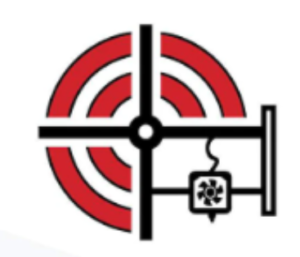Rapid Liquid Print (RLP) turned heads earlier this year with a futuristic silicone handbag made for fashion house Coperni, printed using the company’s 3D technology. But for co-founder and CEO Schendy Kernizan, this high-profile collaboration was only the most visible part of a longer journey, one that started in the research labs of MIT and has grown into one of the most quietly innovative startups in the additive manufacturing (AM) world.
“There’s never a dull moment,” Kernizan reflected during my visit to RLP headquarters in Boston. “Building a business is like a rollercoaster. But with the right team, you start enjoying every milestone, even the small ones. The energy is different from a lab, but just as creative. Instead of testing new ideas every week, you focus on building one big idea and bringing it to life.”

RLP’s Coperni bags on display at RLP headquarters in Boston. Image courtesy of 3DPrint.com
Indeed, A Playground for Ideas
The seeds for RLP were planted at MIT’s Self-Assembly Lab, where Kernizan worked alongside co-founders Bjorn Sparrman, Skylar Tibbits, and Jared Laucks. The lab was, as Kernizan puts it, “a playground” where academic exploration met design challenges from the real world. When Steelcase, a major office furniture company, approached the lab with a question about the future of furniture manufacturing, it sparked something unexpected, he said.
The team realized that AM was struggling with three major barriers: materials weren’t strong or flexible enough, printing large parts took too long, and scalability was limited by molds and supports. So they began to experiment. One idea in particular involved drawing directly inside of a gel, letting the gel suspend the printed material in space without gravity or supports.
It worked.
“That early prototype laid the foundation for what would become RLP’s signature process, the Rapid Liquid Printing, and after sharing it publicly, the feedback was immediate and overwhelming. There was so much excitement,” Kernizan recalled. “We realized this was bigger than a research project. We had to start a company.”
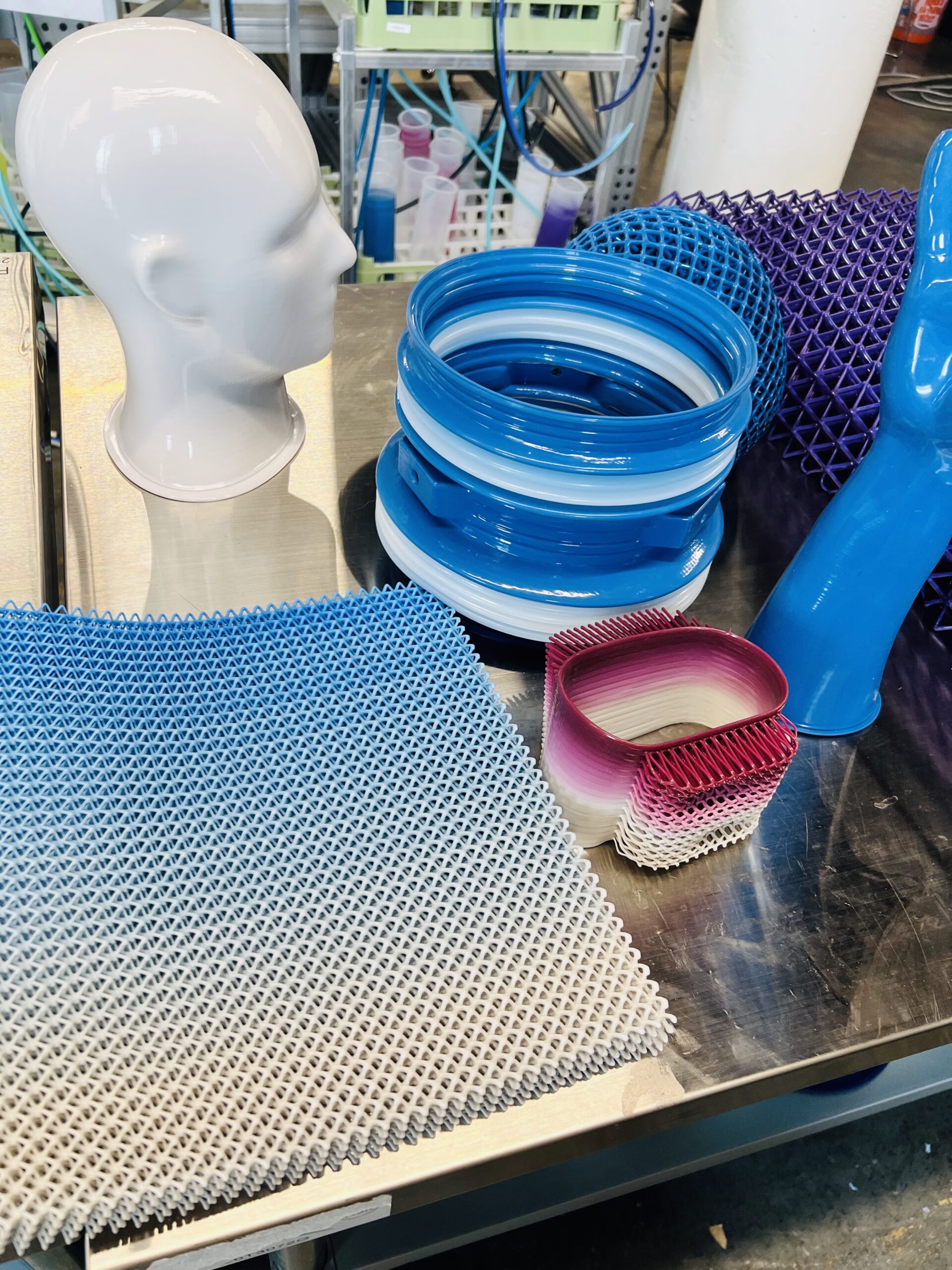
3D printed parts at RLP’s headquarters in Boston. Image courtesy of 3DPrint.com.
We Had to Start a Company
While Tibbits and Laucks remained at MIT to continue lab work, Kernizan and Sparrman took the leap. They launched RLP in 2020 and quickly learned that turning lab tech into a business would require more than just their research.
“It’s a totally different challenge,” Kernizan said. “You’re not just thinking about the science anymore, you’re thinking about the team, the materials, the software, and the business model. Every piece matters if you want to turn a good idea into something real.”
Rather than rushing to sell machines, the team made a strategic move; they would act as a service bureau first. By printing parts for others, they could “stress-test the technology, discover what markets were most promising, and refine the process before ever putting a printer on the market.”
This approach gave them valuable insight. They found early traction in healthcare by printing customized prosthetic liners and orthotic parts from medical-grade silicone. They also explored applications in footwear, aerospace, automotive, and even space research. In one MIT-linked project, they assisted a research team in developing flexible silicone structures designed to support growth experiments in space. The parts were printed on short notice and sent into orbit for testing as part of a broader NASA-affiliated collaboration.
“We wanted to build something real,” said Kernizan. “We didn’t want to overpromise. A lot of companies made big claims early on, and it hurt investor confidence in the industry. We knew we had something powerful, but we also knew we had to prove it first, by delivering, not just talking.”
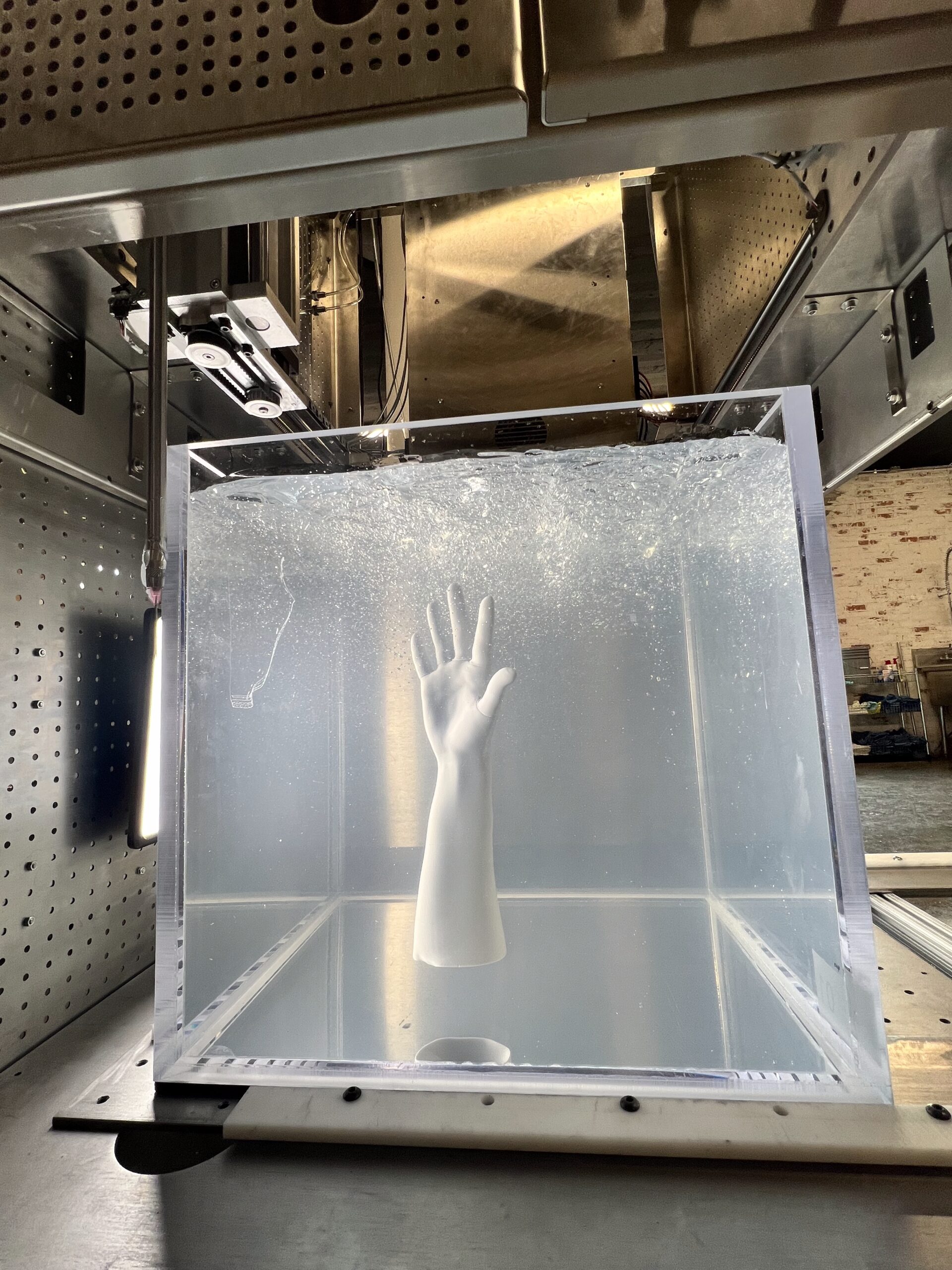
RLP’s gravity free 3D printing at work. Image courtesy of 3DPrint.com
Prove It First
Today, RLP operates out of about 4,000 square feet in Charlestown, Massachusetts. The core team of 11 full-timers has stayed small on purpose, says Kernizan, and is supported by interns and co-ops from nearby schools like Northeastern, MIT, and Wentworth.
With the right team in place, RLP was ready to make its next big move. Earlier this year, it debuted its first commercial printer, Levity™, at the RAPID + TCT show. Designed for quiet, clean, and gravity free printing of silicone parts, Levity™ marks a new phase for RLP, bringing its once-secretive process to market.
“Levity™ is our flagship commercial machine that we’ll be starting to ship in 2026,” Kernizan confirmed. “We have a waitlist open and some early interest already. In fact, we are in conversations with individuals and companies interested in purchasing the machine. Some of them we might squeeze in this year as early adopters to give us feedback.”
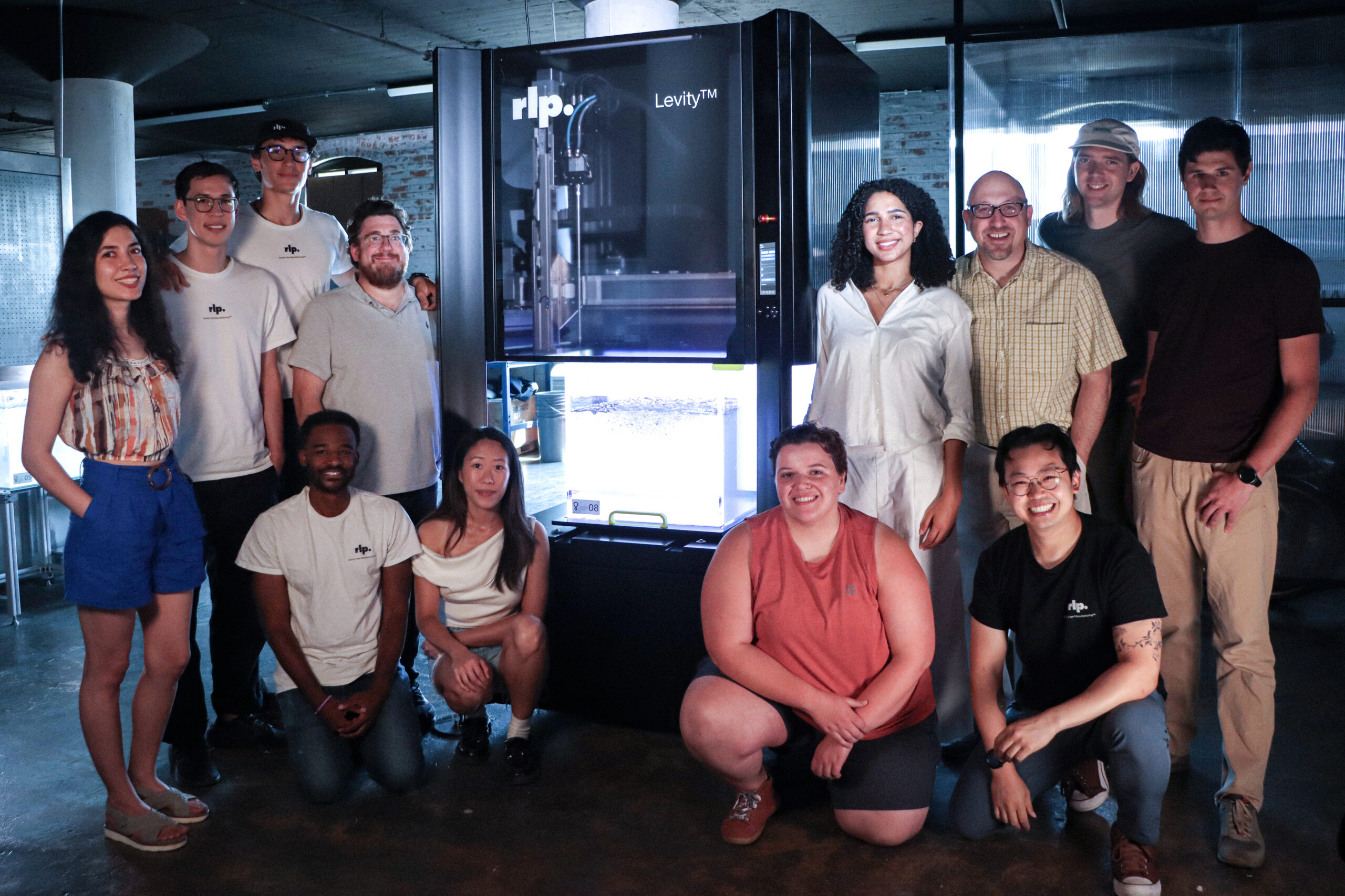
The RLP team with Levity™. Image courtesy of RLP.
Early Interest Already
Actually, it was its authentic approach to AM that helped RLP land one of its most high-profile projects: a collaboration with Coperni for a series of 3D printed handbags. The partnership came through connections at MIT, and while the initial purse design wasn’t optimized for RLP’s process, the team managed to pull it off anyway, printing glossy bags that were later laser-etched, cleaned, and shipped overseas.
“I didn’t expect to ever print a purse,” Kernizan laughed. “But I think that’s what makes this so fun. You get asked to do things that you’d never plan for, and it opens up entirely new ideas.”
He sees fashion as a growing market, especially if designers start creating with RLP’s process in mind: “We’d love to co-develop something that’s truly designed for gravity free printing.”
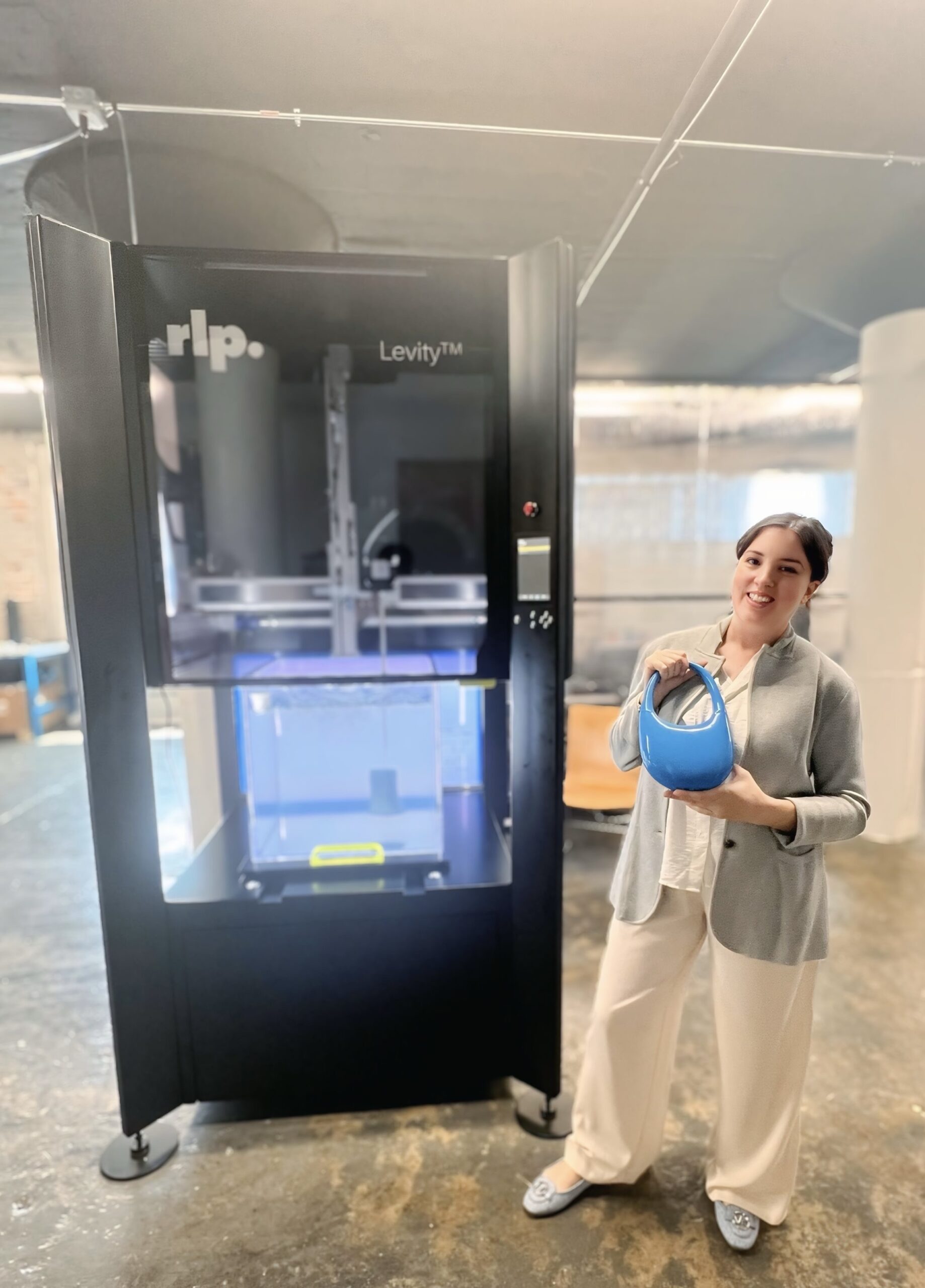
Vanesa Listek holding the Coperni bag at RLP’s headquarters in Boston. Image courtesy of 3DPrint.com.
RLP isn’t just changing the technology; it’s also changing how we think about 3D printing. Kernizan doesn’t even like using the term “3D printing,” instead calling RLP a “platform for manufacturing.” That difference matters, he says, because “when you say ‘3D printing,’ people have certain ideas, especially about supports, layers, and post-processing. But this is something different.”
Instead of building support structures or wasting excess material, RLP lets users “print what you need and nothing more.” There’s no sanding, curing, or toxic cleanup. During my visit, one of the machines was printing live in plain sight; it was clean, quiet, and surprisingly fast. Kernizan walked me through the part as it was printed, showing how simple and streamlined it really is. And because they use materials already approved for casting and molding, customers can skip the lengthy certification process.
Still, the company isn’t rushing into every new material or idea: “We’ve had to stay focused. Sometimes we’ll put an idea on the board and revisit it later, when the timing or partner is right. Right now, RLP works primarily with platinum-cure RTV silicone, which is safe for skin and widely used in medical and consumer applications. But the long-term vision goes much further.
“We started with medical, prosthetics, and orthotics,” he said. “Eventually, we want to move toward implantables, or consumer goods like footwear, where RLP is already working with a few companies on performance and recovery-focused designs.”
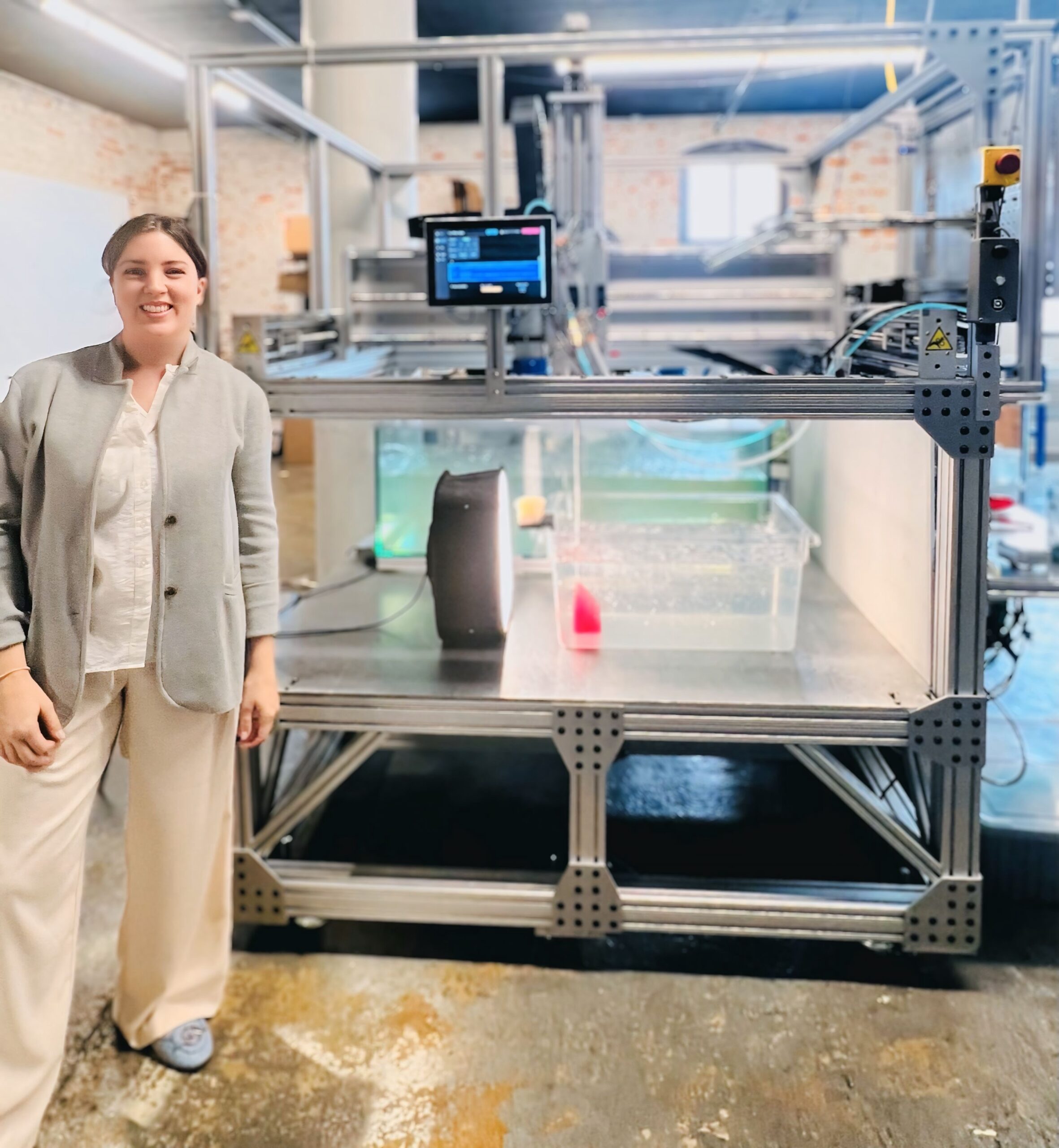
Vanesa Listek next to RLP’s prototype printer Vanesa Listek at RLP’s headquarters in Boston. Image courtesy of 3DPrint.com.
On the more industrial side, RLP is seeing demand for gaskets and seals in sectors like aerospace and automotive, especially as their build volume (500 mm cubed) opens up new possibilities. And because the process is so quiet and open, watching it happen feels different than traditional machines.
“This one’s printing a prosthetic part right now,” Kernizan told me during the visit, pointing to a softly glowing tank behind him. “You’ll be able to see the full part before you leave.” The part was printing live, fully visible through the clear tank, backlit by RLP’s built-in display, and took
30 minutes to print. Real-time updates showed elapsed time, remaining print time, and material usage, turning the entire machine into a kind of manufacturing dashboard.
“Our spirit of openness and iteration is what makes the work exciting. Even more interesting is that we haven’t hit the ceiling of what this process can do. Every new request, every new application—it shows us what’s possible,” he concluded. And in a field often filled with noise, RLP’s quiet confidence stands out.
Subscribe to Our Email Newsletter
Stay up-to-date on all the latest news from the 3D printing industry and receive information and offers from third party vendors.
